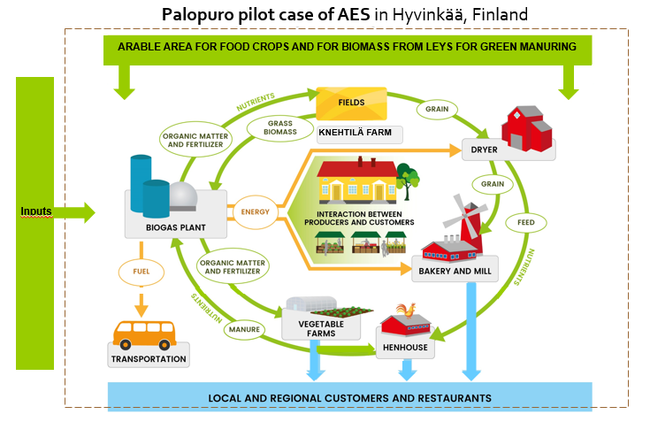What is Agroecological Symbiosis? This is usually the first question raised by farmers or other audiences regarding our project. We first considered changing the name to better address the design of a new nutrient and energy self-sufficient food production system. But after a while we noticed that, in addition to getting the audience to listen, the name actually described our work nicely. So, what is Agroecologial Symbiosis?
Agroecological Symbiosis (AES) refers to a model of food production in which the participating farms, food processors and energy producers operate locally together. AES is an implementation of industrial ecology and symbiosis in food production. Agroecology refers to ecologically sustainable agriculture and symbiosis describes cooperation between different actors.
Sounds still a bit theoretical? The name comes from a funding application to design functions of the first real-life Agroecological Symbiosis actively forming in the village of Palopuro, Southern Finland. This project aims to produce local, organic food using bioenergy and recycled nutrients. The model is based on a cooperation which benefits each partner of the symbiosis. However, all operations are also individual businesses aiming to gain an economic profit. The centre of Palopuro AES is Knehtilä Farm, an organic cereal farm cultivating oat, wheat, rye, barley, peas, faba beans, buckwheat and green manure leys on an area of 380 hectares. Other farms include a neighbouring hen house and a vegetable farm. Their feed production and manure management are all integrated in Knehtilä’s production. 
Energy for the grain drying, farm machinery, food processing, and sales will be produced from locally available biomasses in a biogas plant, operated in cooperation with local actors and a regional energy company. The biogas plant will start to operate in autumn 2018. In the future, the produced grain will be milled and subsequently used by a bakery which is planning to move its operations to the Knehtilä farm. There are also plans to integrate organic greenhouse production into biogas production.
Greater profitability is gained in various ways and each farm finds its motivation from different sources. For example, the regional energy company is interested in producing renewable energy in a sustainable way, farms expect increases in crop yields, some might appreciate the better image of agriculture and some participate only for economic reasons. Economic benefits might also be gained indirectly by working in close proximity to enable a new kind of co-evolution in food processing, entailing completely new opportunities.
Increases in productivity will be the result of enhanced nutrient recycling with the biogas plant at the core of this system. Green manure leys, crop residues and manures will be used as a feedstock for biogas production, which is then utilized for grain drying, the bakery’s ovens, farm machinery and passenger cars. Nutrients will be recycled back into fields to enhance productivity in the form of digestate. This model has several other environmental benefits because former energy consumers in the value chain are transformed into energy producers. Also, the risk of nutrient leaching is reduced because grass biomass is harvested instead of decomposing in the field (conventional practice).
Palopuro AES has attracted a lot of interest among other entrepreneurs and producers in Finland but also internationally. In the future, Agroecological Symbiosis could be an answer to many challenges that agriculture is facing. In addition to increasing agricultural production with trying to minimize environmental trade-offs, symbiosis also creates regional food cultures, increased rural livelihoods while boosting local economies.
